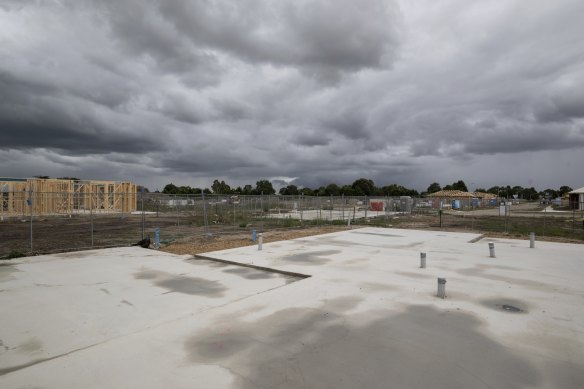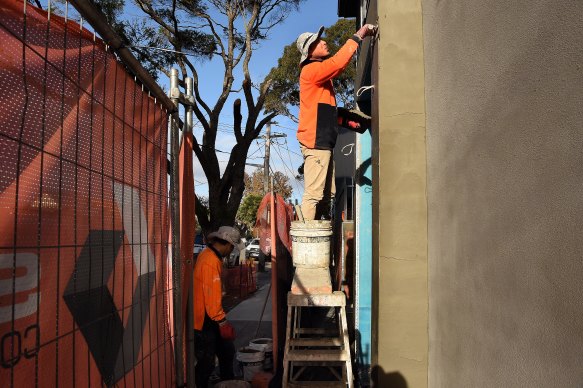When a respected builder goes under, economic alarm bells start to ring

The economy may look to be built on rock solid foundations.
But you don’t need to look very far to get a sense that there could be some dangerous structural cracks forming, compounded by the Reserve Bank’s single-minded determination to jack-hammer inflation under control with higher interest rates.
On Friday, those economic fault lines subsumed two big construction companies: residential builder Porter Davis Homes, which is currently building about 1700 homes in Victoria and Queensland, and Lloyd Group, which specialises in design and construction work for state and local governments in Victoria and NSW.
Hundreds of families have been left high and dry by the collapse of Porter Davis.Credit:Penny Stephens
Talk to people in the industry and they’ll tell you the situation is uniquely dire, with a confluence of short and long-term forces almost certain to inflict more pain.
Porter Davis is not only big, it is regarded in the industry as a highly professional business, making the news that liquidators have been called to help salvage it all the more shocking.
As Matthew Kandelaars, chief executive of the Victorian branch of the Urban Development Institute of Australia put it on Friday, “if this can happen to Porter Davis, it really makes people sit up and take notice”.
The crisis can be traced back the depths of the pandemic. Generous government house building stimulus measures designed to ward off economic collapse pulled forward a huge volume of construction activity.
Builders locked in tens of thousands of fixed price contracts in the race to capitalise on the federal HomeBuilder scheme, which offered $25,000 grants for newly built homes. In Victoria alone, the number of blocks of land sold for building more than doubled in 2021 to around 32,500.
The problem was, the surge in demand happened not only across Australia, but around the world, as other wealthy countries introduced similar house building stimulus schemes.
The cost of raw materials and labour surged to meet the boom. That left builders who had locked in fixed price contracts dangerously exposed, and facing large losses.
The situation was greatly compounded by skills shortages (as tens of thousands of foreign workers returned to their home countries) and a global supply chain logistics nightmare for building inputs linked to the pandemic.
The building industry is under pressure on multiple fronts.Credit:Kate Geraghty
Then came the Russian invasion of Ukraine, which pushed the price of oil and other commodities even higher, adding to the sector’s woes.
The price of wood, steel, glass, plastics, cement, PVC, aluminium and other building inputs soared.
As far back as May last year, when news emerged that another home building giant, Metricon, was potentially in trouble, economists and construction industry experts were warning of a “major correction” for the construction sector. They weren’t wrong.
Australian Bureau of Statistics figures show nationally, dwelling approvals rose from 13,000 in June 2020 to a peak of more than 23,000 in March 2021, the second-last month of the federal HomeBuilder scheme. Approvals have since fallen to about 12,000 in January this year.
The outlook is grim. According to data from the Australian Securities and Investments Commission, construction industry insolvencies have almost doubled to 1447 for the nine months to March 12, 2023, up from 761 for the same nine-month period a year earlier.
According to property sector analyst CoreLogic, average construction costs increased by a record 11.9 per cent in 2022, after a 7.3 per cent jump the year before that. Those sorts of price increases are not expected to continue, but for many the damage has been done.
Now home builders, particularly those in Victoria, are struggling to compete against soaring infrastructure spending by state governments – which is also continuing to push up demand for labour, raw materials and contractors – and that’s before even factoring in the impact of the most aggressive program of interest rate rises for decades.
Ross Gittins unpacks the economy in an exclusive subscriber-only newsletter every Tuesday evening. Sign up to receive it here.
Most Viewed in National
From our partners
Source: Read Full Article

